
The southern fulmar is a seabird of the Southern Hemisphere. Along with the northern fulmar, F. glacialis, it belongs to the fulmar genus Fulmarus in the family Procellariidae, the true petrels. It is also known as the Antarctic fulmar or silver-grey fulmar.

Halichondria panicea, commonly known as the breadcrumb sponge, is a species of sea sponge belonging to the family Halichondriidae. This is an abundant sponge of coastal areas of the North Atlantic and the Mediterranean Sea ranging from the intertidal zone to a recorded depth of over 550 m. It is also found in the intertidal zone of the coast of the northern part of the North Island of New Zealand. It is very tolerant of a wide range of coastal habitats, including strong currents, high salinity and exposure to powerful wave action. Its only requirement is a rocky substrate which can include small cobbles.
The crumb-of-bread sponge is a species of sea sponge in the class Demospongiae.

The orange wall sponge is a species of sea sponge belonging to the order Trachycladida. It is found in the south Atlantic and Indo-Pacific oceans. Around the South African coast, it is known from the Cape Peninsula to Cape Agulhas.
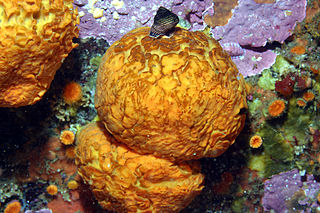
Tethya aurantium, also known as the golf ball sponge or orange puffball sponge, is a species of sea sponge belonging to the family Tethyidae. It is spherical in shape, with a warty surface, and grows to about 10 cm in diameter. Oscula are present on the upper surface. The surface has sharp protruding spicules which can cause skin irritation if touched.
Clathria dayi, the broad-bladed tree sponge, is a species of demosponge. It is known from the west coast of South Africa and around Cape Point to False Bay. It is probably endemic to this region.
The red encrusting sponge is a species of sea sponge. It is known only from the South African coast, on both sides of the Cape Peninsula. It is endemic to this region.
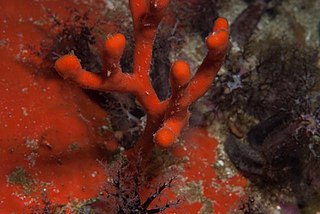
The tree sponge is a species of demosponge. It is known from the west coast of South Africa to Cape Agulhas. It is endemic to this region.
The brain sponge is a species of marine demosponge in the family Isodictyidae. This sponge is known from the west coast of South Africa to Port Elizabeth. It is endemic to this region.
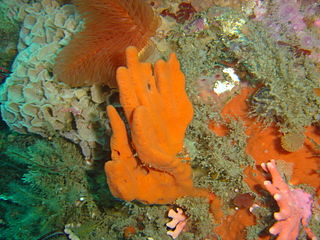
The flat leaf sponge is a species of marine demosponge in the family Isodictyidae. This sponge is known from the west coast of South Africa to False Bay. It is endemic to this region.
The yellow encrusting sponge is a species of sea sponge in the family Biemnidae. This sponge is known from the west coast of South Africa to Port Elizabeth. It is endemic to this region.

Haliclona anonyma, the turret sponge or tubular fan sponge, is a species of demosponge. It is endemic to South Africa, where it occurs between the Cape Peninsula and Sodwana Bay.

Haliclona stilensis, the encrusting turret sponge, is a species of demosponge. It is known around the southern African coast, from Namibia to the South African south coast.
The black stink sponge, is a species of sea sponge in the family Irciniidae. This sponge is known around the Australian coast and around South Africa from the Cape Peninsula to Cape Agulhas.
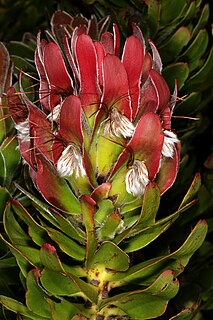
Mimetes fimbriifolius, also called cowl pagoda or the fringed pagoda, is a species of plant in the family Proteaceae. It is a dense, rounded, multi-branched tree that grows up to 4 metres in height. This attractive and striking plant flowers all year round, and produces red and yellow branch-heads and inflorescences. The nectar-rich flowers are pollinated by sunbirds and the seeds are distributed and taken underground by ants before germinating. It is endemic to the Table Mountain range in the city of Cape Town, South Africa.
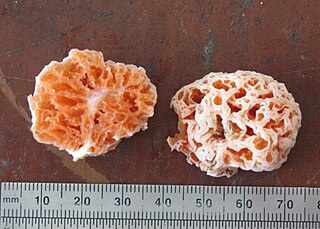
Spongiforma squarepantsii is a species of fungus in the family Boletaceae, genus Spongiforma. Found in Malaysia, it was described as new to science in 2011. It produces sponge-like, rubbery orange fruit bodies that have a fruity or musky odour. The fruit bodies reach dimensions of 10 cm (3.9 in) wide by 7 cm (2.8 in) tall. Like a sponge, they will resume their original shape if water is squeezed out. The spores, produced on the surfaces of the hollows of the sponge, are almond-shaped with rough surfaces, and measure 10‑12.5 μm by 6‑7 μm. The name of the fungus is derived from the Nickelodeon cartoon character SpongeBob SquarePants from the show of the same name. S. squarepantsii is one of two species in Spongiforma; it differs from S. thailandica in its color, odour, and spore structure.

The multicoloured sea fan is a species of gorgonian sea fan in the family Melithaeidae.
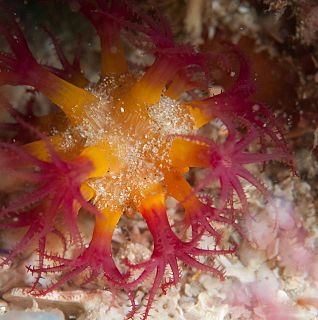
The variable soft coral is a species of colonial soft coral in the family Alcyoniidae.

Leucospermum tomentosum is an evergreen, mostly spreading shrublet of approximately 75 cm (3 ft) high and up to 3 m (10 ft) in diameter, with alternately set, linear or narrowly spade-shaped, grey felty leaves, with one to three teeth near the tip. It has round, seated flower heads of 3–3½ cm (1.2–1.4 in) in diameter, occurring in groups of one to four, and consisting of deep yellow, very sweet scented flowers. It can survive the occasional wildfire because it regenerates from the underground rootstock. It is an endemic species that is restricted to a narrow strip along the Atlantic coast of the Western Cape province of South Africa. The species flowers between June and November. It is called Saldanha pincushion in English.
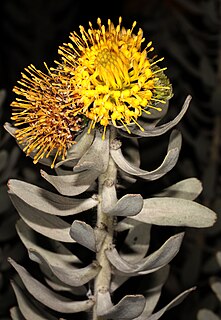
Leucospermum rodolentum is an upright, evergreen shrub of up to 3.0 m high, from the family Proteaceae. It has felty grey, elliptic to wedge-shaped leaves of 4–6½ cm (1.8–2.6 in) long and ¾–1½ cm wide, and very sweetly scented, globe-shaped, 3–3½ cm (1.2–1.4 in) wide, bright yellow flower heads, that are seated or on a very short stalk of ½ cm long, grouped with two to four together. Its common names include is sandveld pincushion in English and sandluisie or sandveldluisiesbos in Afrikaans. The plants are in bloom between August and November. It is an endemic species that only grows in a small area of the Western Cape province of South-Africa.














